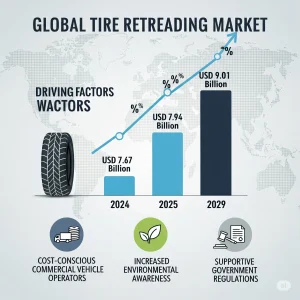The tyre retreading industry is experiencing growth within the automotive and manufacturing sectors. Tyre retreading involves refurbishing used tyres with a new tread redeployed onto the existing casing. Retreading tyres have multiple advantages including extending the life of the tyre, responsible savings, and responsible considerations for the environment. An organization or fleet operator can expect to save up to 50 percent the cost of purchasing a new tyre.
Different Types of Tyre Retreading Processes
Hot Retreading
Hot Retreading – Hot retreading means adding a new tread to an acceptable prepared tyre casing and then curing it with heat and pressure. This type of process is preferred for heavy commercial vehicles such as trucks and buses because it allows for longer distances and heavier loads because of the durability of the tyres.
Cold Retreading
Global Market Outlook

The global market for retreading tyres is expanding at pace, driven largely by cost-consciousness of commercial vehicle operators, a higher growing awareness of environmentalism, and legislation from governments to support retreading tyres. In 2024, the market is valued at around USD 7.67 billion and is projected to value USD 7.94 billion by 2025, and grow to approximately USD 9.01 billion by 2029. This shows the demand for retreading tyres is steadily increasing.
Growth is stimulating by growing commercial vehicle fleets, more awareness of cost-effective tyre solutions, and the move to sustainable manufacturing practices. Retreading tyres confer both economic advantages to businesses and also support global efforts to reduce its waste and carbon footprints.
Comprehensive Project Report on tyre retreading
Regional Overview
The Asia- Pacific region is the leading tyre retreading industry and covering over 60% of the global market share. Regions that are experiencing rapidly growing demand over the following years include countries like India, China, and in Southeast Asia inspired by better infrastructure improvements, growth in logistics, and demand from small and medium fleets operators. Europe and North America also show growing demand factors to look out for as well, especially with government regulations that support retreading for environmentalism.
Related article:- How to start a Tyre Retreading Business
Tyre Retreading Process
The retreading process of tyres can be complicated and technical which requires extensive focus in order to ensure tyre integrity and safety. The process begins with a thorough inspection of the serviceable used tyre to look for any structural damage, deep cuts, or sidewall problems. If the tyre does not pass their inspection, they will dispose of it, to ensure the safety and quality of the retreaded tyre.
Afterwards, during buffing, they will then remove the worn tread to expose a smooth surface for new tread application. After buffing, during skiving, they will remove any excess rubber that remained as well as create a textured surface to create a stronger bond with the new tread. They also will apply a bonding agent before placing the new tread onto the tyre casing.
Establishing a Tyre Retreading Plant
Role of Niir Project Consultancy Services (NPCS)
Entrepreneurs interested in the tyre retreading business can greatly benefit from consulting services like Niir Project Consultancy Services (NPCS). NPCS produces market surveys and detailed feasibility reports that analyze market trends, demand forecasts, and project viability.
Their reports offer insights into the manufacturing process, plant layout, and sourcing materials, helping entrepreneurs understand what is needed to run a tyre retreading facility. While NPCS does not provide detailed financial figures, its assistance helps businesses evaluate feasibility and potential success, reducing operational risks and boosting sustainability chances.
To learn more, explore our books.
Opportunities for Entrepreneurs
The tyre retreading industry offers significant opportunities for small and large entrepreneurs alike. As e-commerce and logistics grow, commercial fleets need cost-effective tyre solutions, leading to consistent demand. Businesses can also promote eco-friendly branding through retreading, appealing to environmentally aware customers. Emerging markets with expanding transportation networks present high potential for new retreading facilities, and partnerships with tyre dealers, fleet operators, and logistics companies can provide a steady demand.
Conclusion
The tyre retreading industry offers a sustainable and profitable avenue for entrepreneurs looking to enter the manufacturing field. Furthermore, with a growing global market, cost-effective solutions, and a clear manufacturing process, starting a tyre retreading business is a promising opportunity. Therefore, by using consultancy services like NPCS, entrepreneurs can gain valuable insights into market dynamics, production methods, and operational efficiency, ultimately paving the way for a successful business.
Discover the best business ideas for you using our startup selector tools.
Frequently Asked Questions
Q: What is tyre retreading?
A: Tyre retreading is the process of restoring used tyres by replacing the worn-out tread with a new layer, extending the tyre’s life while being cost-effective and environmentally friendly.
Q: What are the main methods of tyre retreading?
A: The two primary methods are hot retreading, which uses heat and pressure, and cold retreading, which uses a pre-cured tread applied with a bonding agent.
Q: What are the benefits of retreaded tyres?
A: Retreaded tyres save costs, reduce raw material consumption, minimize industrial waste, and perform similarly to new tyres under normal conditions.
Q: Who can benefit from tyre retreading?
A: Commercial vehicle operators, logistics companies, fleet managers, and environmentally conscious businesses benefit from tyre retreading.
Q: Is retreading safe for all types of vehicles?
A: When done according to industry standards, retreading is safe and durable, especially for commercial and industrial vehicles.







